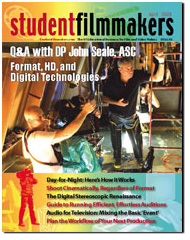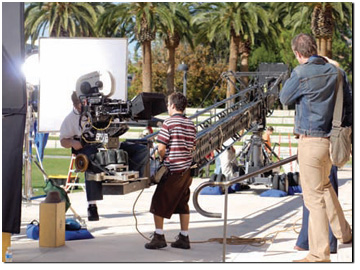Check out this
article in the print edition of StudentFilmmakers
Magazine, April 2008. More photos and gaffer sidebar
included in print edition. Click
here to get a copy and to subscribe >>
 Lighting
Period War Film, Shades of Hope Lighting
Period War Film, Shades of Hope
Separating Worlds through Color
by Kevin Zanit
....Continued
from Previous Page
Our back home portions of the film were shot first. For these
scenes, I sought a look that was naturalistic, yet had a somewhat
�lit� look that was common in films of the period. To achieve
this, we tended to use more lights on day exteriors than we normally
would. This approach resulted in some very pretty images that
really contrasted with the look planned for the Vietnam world.

Key Grip Bobby Woo checking for lens flares.
The world of Vietnam marked a major style change for us. We switched
to the flare lenses and 5229 film stock with a full skip bleach
on the negative.
There were several major challenges that waited for us in Vietnam.
Most of the film took place in a forward base camp that consisted
of many tents, sandbags, watch towers and all other kinds of military
equipment. Production designer Zach Bliss did a great job of building
the camp at Disney Golden Oak Ranch in a way that helped hide
buildings that did not belong (like a barn) from camera. He did
all this while having a small crew, budget and amount of time
to accomplish the huge task.
One of the biggest challenges was the sheer amount of dialogue
to cover inside of our �hero� tent. Not only were there several
long dialogue scenes in this tent, but most of the scenes involved
numerous actors, all moving around the tent. Brie and I agreed
that the only way we could really cover these scenes in the time
we had was to bring in an extra camera. It would have been great
to have two cameras for the entire shoot, but that was not an
option financially.
I wanted the tent scenes to be fairly dark. I motivated most of
the lighting through windows or the opening in the tent. I just
let the light in the tents fall off into darkness while using
a minimal amount of fill light. For the scenes with two cameras,
�A� camera 1st AC Ken Bender would bump up to operate, and either
I or Mike Lyons, our �B� camera operator, would operate the other.
During many of the scenes, we had our �A� camera covering more
conventional coverage and had the �B� camera roaming around finding
interesting shots. Some of the material gathered with this technique
turned out beautifully and really made me wish I could have kept
the other camera for the entire shoot!
Another major scene for us was a mortar attack on the camp. This
involved several large explosions in the middle of the camp with
lots of soldiers running for cover. This was the opening scene
of the movie. Brie and I wanted the shot to start calm, and then,
with no warning turn chaotic. The point was to illustrate how
our characters had to live in a constant state of unease never
knowing when the next attack would be. I suggested we try to cover
the scene in one moving take. The shot started handheld high up
on a crane looking down into the camp. After a moment, the explosions
started. As the explosions moved through the camp, the crane lowered,
and the camera stepped off the crane and moved quickly forward
through the camp.
Continued
on Next Page...
|

